Changsha Huanghua International Airport
| Changsha Huanghua International Airport | |||||||||||||||
|---|---|---|---|---|---|---|---|---|---|---|---|---|---|---|---|
 | |||||||||||||||
|
| |||||||||||||||
| Summary | |||||||||||||||
| Airport type | Public | ||||||||||||||
| Operator | Hunan Airport Management Group Co., Ltd. | ||||||||||||||
| Serves | Changsha, Hunan | ||||||||||||||
| Location | Huanghua, Changsha County, Hunan | ||||||||||||||
| Opened | 29 August 1989 | ||||||||||||||
| Focus city for | |||||||||||||||
| Elevation AMSL | 66 m / 217 ft | ||||||||||||||
| Coordinates | 28°11′48″N 113°13′15″E / 28.19667°N 113.22083°ECoordinates: 28°11′48″N 113°13′15″E / 28.19667°N 113.22083°E | ||||||||||||||
| Website |
csa | ||||||||||||||
| Maps | |||||||||||||||
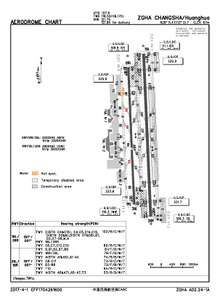 CAAC airport chart | |||||||||||||||
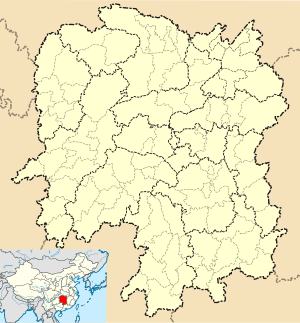 CSX Location of airport in Hunan  CSX CSX (China) | |||||||||||||||
| Runways | |||||||||||||||
| |||||||||||||||
| Statistics (2017) | |||||||||||||||
| |||||||||||||||
| Changsha Huanghua International Airport | |||||||
| Traditional Chinese | 長沙黃花國際機場 | ||||||
|---|---|---|---|---|---|---|---|
| Simplified Chinese | 长沙黄花国际机场 | ||||||
| |||||||
Changsha Huanghua International Airport (IATA: CSX, ICAO: ZGHA, CAAC LID: HHA)[1] is the airport serving Changsha, the capital of Hunan province, China, as well as nearby cities such as Zhuzhou and Xiangtan. As of 2016, it is the 13th busiest civil airport in China. Located about 25 kilometres (16 mi) from downtown Changsha in the town of Huanghua in Changsha County, the airport has two terminal buildings. The airport is managed by the Hunan Airport Authority, a publicly owned corporation managing all five airports in Hunan Province. Huanghua airport was opened in August 1989, replacing Changsha Datuopu Airport, which is now a military air base.
Terminals
Terminal 1
Terminal 1 has three concourses. Concourse T1-A covers an area of 34,000 square meters, Concourse T1-B 13,200 square meters and Concourse T1-C 6,100 square meters. The proposed capacity was 6.5 million passengers annually. Terminal 1 was closed and underwent renovations after the new Terminal 2 became fully operational in July 2011. Terminal 1 is expected to re-open in the next year for the increasing passengers. Parking areas P5 and P6 are outside the terminal.
Terminal 1 and concourses |
Terminal 2
The inauguration of Terminal 2 was on July 19, 2011. With 212,000 square meters of space, the new terminal is the 5th largest airport terminal in mainland China (after Beijing–Capital, Shanghai–Pudong, Guangzhou, and Shenzhen). The 39.9m tall main building of Terminal 2, being 672m in length and 168m in depth, is the largest single steel-truss structure in Hunan. The new terminal has 22 bridge gates, to which the longest passenger walking distance is within 300m. With this new facility, the airport can handle 151,000 aircraft movements and another 15.6 million passengers every year. The peak hour volume of passengers is 3,940.
The Departure Hall has 4 automatic double-glass-door entrances which are directly facing Check-in Areas A,B,C & D respectively. Entrances 1-3 are domestic entrances and Entrance 4 is for International, Hong Kong, Macau and Taiwan Departures, which will be checked in at Area D. Area A is the exclusive check-in Area for China Southern Airlines. Area B&C are domestic check-in areas for other airlines. The terminal has 80 check-in counters and 24 self-checkin kiosks, 24 security checkpoints and more than 6,390 seats.
The Arrival Hall is equipped with 8 baggage carousels (6 at domestic area and 2 at international area). The indoor parking garage P4, which has 693 parking spaces, is on floor B2. There are also three outdoor parking areas, P1,2&3, which provide over 1000 parking spaces.
 Terminal 2 Departure Hall |
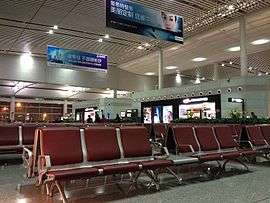 International area inside Terminal 2 |
History
From 1957 to 1989, Datuopu Airport served as a dual-use military and civil airport for Changsha. It was only capable of handling small aircraft and a few flights per day. The Hunan Provincial Government proposed the construction of a new airport in October 1984, which was approved by the State Council of China. Construction for Huanghua Airport began in June 1986, and it was opened on 29 August 1989, when all civil flights were transferred to the new airport, and Datuopu reverted to sole military use.[2][3]
On October 28, 2000, the 34,000-square-meter Terminal 1-A, which costs 40.4 million CNY, was open. The airport was capable of handling 4.6 million passengers per year. Afterwards, the construction of Terminal 1-B and Terminal 1-C were finished to ensure growing passengers and cargo.
The airport went through a major expansion in 2008–2011, with lengthening of runway 18/36 from 2600m to 3200m and the addition of Terminal 2 which went into operation in 2011.
The construction of the second runway was completed in November, 2016. The new 3800mx60m Code-4F runway is parallel with the current 18/36 runway and lies 380m to the east. The second runway was due for operation in early 2017 thus enabling A380 flights.
Terminal 1 is also undergoing renovation to allow for the handling of increasing passengers. Meanwhile, the cargo facilities and freighter stands are expanding.
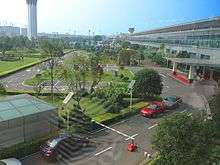
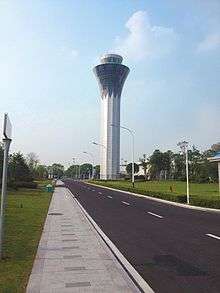

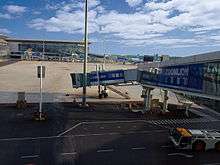
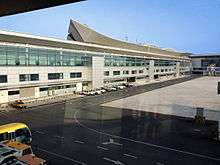
Short-Term Expansion (2020)
The airport is undergoing a major expansion eastwards. After the completion of the 2nd runway, Terminal 3 and the east terminal area will be constructed on the east side of it. The airport will be capable of handling 31 million passengers, 320 thousand tons of cargo and 260 thousand aircraft movements annually. The airport becomes a hub in Central China that covers 1,648 hectares of land after this stage. A third runway of 3600m in length will also be constructed and ready for use in 2021.
Long-Term Expansion (2030)
The third parallel runway of 3600m (4E) will be built to the east of Terminal 3&4, and it is 2000 meters away from the second runway. More concourses are to be added to increase the passenger capacity of Terminal 3. And Terminal 4 is to be constructed beside Terminal 3. The east terminal area, in which both Terminals 3&4 lie, is located between the 2nd and 3rd Runways. At the final stage, the fourth parallel runway (3600m) of 4E will be constructed 1035m in the east of the third runway. Two underground tunnels connecting the west area (Terminal 1&2) and the east terminals (Terminal 3&4) are considered.
The long-term expansion will take up another 2,687 hectares. Changsha Huanghua Int'l airport will become a major hub in China which hosts a number of based airlines. The ultimate capacity of the airport will be 71 million passengers, 1.8 million tons of cargo and 550 thousand movements annually.
Airlines and destinations
Statistics
As for 2016, Changsha Huanghua International Airport was the 13th busiest airport in the People's Republic of China with 21,296,700 passengers.
| Year | Passengers | % Change | Cargo (tons) | Aircraft Movements |
|---|---|---|---|---|
| 2016 | 21,296,700 | |||
| 2015 | 18,715,278 | |||
| 2014 | 18,020,501 | 125,037.8 | 152,359 | |
| 2013 | 16,007,212 | 117,588.7 | 137,843 | |
| 2012 | 14,749,701 | 110,608.0 | 127,041 | |
| 2011 | 13,684,731 | 114,831.1 | 116,727 | |
| 2010 | 12,621,333 | 108,635.2 | 115,635 | |
| 2009 | 11,284,282 | 86,995.0 | 110,023 | |
| 2008 | 8,454,808 | 71,151.9 | 85,339 | |
| 2007 | 8,069,989 | 68,629.7 | 82,041 | |
| 2006 | 6,592,602 | 62,571.3 | 71,139 | |
| 2005 | 5,301,396 | 52,360.3 | 59,534 | |
| 2004 | 3,802,550 | 43,133.2 | 55,054 | |
| 2003 | 2,992,543 | 34,987.5 | 46,993 | |
| 2002 | 2,598,508 | 25,437.9 | 42,920 | |
| 2001 | 2,217,088 | 20,375.2 | 39,194 | |
| 2000 | 2,034,526 | - | 18,552.0 | 37,722 |
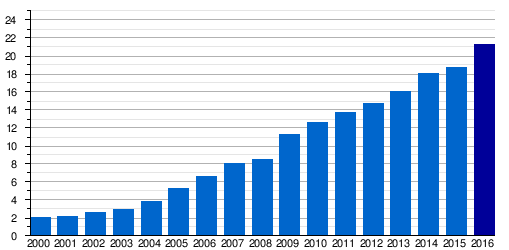 |
Ground transportation
 Interior of Changsha Maglev train (2016)
Interior of Changsha Maglev train (2016) Platform of Changsha Airport Station (2016)
Platform of Changsha Airport Station (2016)- Coaches & Buses services
- Waiting Area for coaches & buses
 Driving on Changsha Airport Expressway(S40)
Driving on Changsha Airport Expressway(S40)- Parking Areas in the airport
Maglev
- Maglev: The regular-speed Changsha Maglev connects Huanghua International Airport and Changsha South Railway Station, it started operation on 6 May 2016.
- The Maglev line is 18.5 km long and trains and runs at a speed of 120kph to finish the journey in just over 10 minutes.[18]
- The ticket price is ¥20 between the Airport and South Railway Station. Metro-card holders can receive a 10% discount.
| Station Name English |
Station Name Hanzi |
Transfer | Location |
|---|---|---|---|
| Changshanan Station | 磁浮高铁站 | 2 | Yuhua |
| Langli | 磁浮㮾梨 | Changsha County | |
| Changsha Huanghua International Airport | 磁浮机场 | ||
Metro
- Metro Line 6: planned and expected to start constructions in following years.
Gallery
- Aerial view of Terminal 1 and 2
- Lifts between Departure & Arrival Floors in T2
- Terminal2 screen walls
- Hallway behind the security checking border inside CSX terminal 2
 Restaurants in Food Court of T2
Restaurants in Food Court of T2 outside Terminal1
outside Terminal1
See also
References
- ↑ 长沙航空口岸
- ↑ Sha, Zhaohua (2018-08-10). "1989年:长沙黄花机场建成通航". Hunan Daily. Retrieved 2018-10-02.
- ↑ "30年前,见证黄花机场开建". Huaxia. Retrieved 2018-10-02.
- 1 2 "AirAsia X adds Changsha service from late-Oct 2018". routesonline. Retrieved 9 October 2018.
- ↑ 东航江苏2018夏秋换季抢先看!
- ↑ 新航季东航在烟台威海开通多条新航线
- ↑ "Hainan Airlines adds Changsha – London Heathrow from late-Mar 2018". routesonline. Retrieved 9 March 2018.
- ↑ "Hainan Airlines plans Changsha – Melbourne launch in Nov 2016". routesonline. Retrieved 10 September 2016.
- ↑ http://airlineroute.net/2015/11/27/bl-cxr-w15/
- ↑ https://www.routesonline.com/news/38/airlineroute/278174/lanmei-airlines-continues-china-expansion-in-mid-may-2018/
- ↑ "This year there are 37 flights from China to Indonesia Tourism Dive Resort Manado". top-news.top. 22 July 2016. Retrieved 27 July 2016.
- ↑ Mandarin Airlines adds Taichung – Changsha service from June 2018 Routesonline 26 April 2018.
- ↑ https://www.routesonline.com/news/38/airlineroute/278894/okay-airways-adds-changsha-cebu-service-from-june-2018/. Missing or empty
|title=(help) - ↑ "Okay Airways adds Changsha – Puerto Princesa from July 2018". routesonline. Retrieved 28 June 2018.
- ↑ "Thai Lion Air plans Chiang Rai – Changsha launch in August 2017". routesonline. Retrieved 26 July 2017.
- 1 2 "Thai Lion Air adds new scheduled charter service to China from late-Sep 2017". routesonline. Retrieved 2 October 2017.
- ↑ "Xiamen Airlines schedules new SE Asia service in W18". routesonline. Retrieved 11 September 2018.
- ↑ Changsha to Construct Maglev Train Archived 2014-01-16 at the Wayback Machine., 2014-01-09
External links
| Wikimedia Commons has media related to Changsha Huanghua International Airport. |
- Official Hunan Provincial Airport Authority website
- Airport information for ZGHA at World Aero Data. Data current as of October 2006.